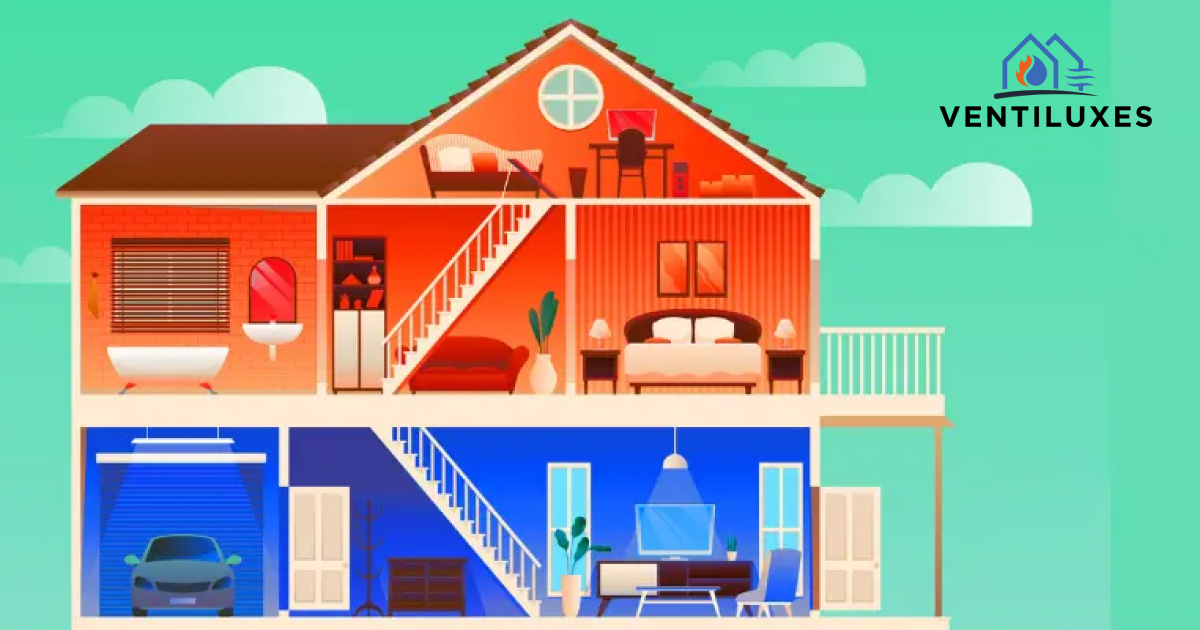People who live in a two-story house enjoy its perks, including more space and a better view of the town. Yet, it often comes with many issues, such as temperature imbalances, mostly due to HVAC inabilities. Since the sun’s rays directly enter the rooms on the second floor, it increases the temperature.
So, if you have poor airflow upstairs, this blog post will teach you how to cure it.
The Second Floor is Warmer – But Why?
You’re not alone if you’ve ever wondered why your second floor feels like a baking oven during the summer months. Many homeowners face this heat challenge, especially in homes with direct sunlight on the upper floors. The science is straightforward: since hot air has a lower density, it rises.
In contrast, the cold air sinks, making the upstairs hotter than the downstairs. This phenomenon occurs daily, as heat from sources like your kitchen or the sun on your roof accumulates and travels upwards, contributing to an uncomfortable environment.
Home’s Structure
The layout of your home also contributes significantly.
For instance, if your kitchen is situated near the stairs, the heat from cooking will quickly make its way upstairs, adding to the warm drafts from other heat sources. Moreover, the roof and sidewalls of your upper portion receive uninterrupted sunlight, further heating the space. These factors and poor airflow can make living on the upper floors more challenging during hot days.
How to Increase Airflow to the Second Floor? – 8 Simple Solutions to Cool Down

Thankfully, there are many solutions to tackle this kind of issue and make your second floor a cooling heaven.
1. Install Fans
To increase the airflow to the second floor, you can turn on the fans of your AC. When you activate fan mode, it keeps the air circulating throughout your home. Since it utilizes low energy, it promotes a more even heat distribution.
Plus, you can install ceiling fans in upper-floor rooms to further assist in moving air around. This helps maintain a fresh air supply. This simple change can transform how your space feels—cooler and more inviting.
2. Attic Insulation
Secondly, think about insulating your attic. By insulating the walls and roof, the inside of your home won’t absorb as much heat. The insulation acts as a barrier, keeping hot air from getting in. When the heat builds up, it will be close to sunset, and the house will cool down overnight before the next sunny day. This method doesn’t use energy and is very effective, especially if your cooling system is outdated.
3. Ductwork Adjustments
If you have old ductwork, keep an eye on your home’s vents. Ensure all supply vents are unblocked and that return vents are clear to facilitate a good air cycle. Sometimes, installing more vents or upgrading their size enhances the airflow draft in upstairs rooms. The vents must have clear space for air to move, preventing any blocked airflow that can occur from furniture or drapes covering them.
4. Check Air Quality
Those living in multi-story homes can’t directly control air quality but can maintain their HVAC systems. If you feel a decrease in the air quality of your home, it’s time to install an air purifier or dehumidifier to control the humidity levels due to HVAC. Or change or clean your air filters regularly to avoid a clogged air filter, which can severely limit airflow and reduce your system’s efficiency.
5. Temperature and Flow Control
Don’t overlook your thermostat and control systems to manage temperature and airflow on your upper floors. No matter the levels of your home, using a zoning panel or adjusting dampers, registers in your ducted system maintain a balance. Setting your thermostat strategically or upgrading to a smart model allows for finer temperature controls. Direct cooling or heating is delivered exactly where needed, while every corner of your home feels just right.
6. Manage the Energy Consumption
Focusing on efficiency is critical when aiming to boost airflow upstairs without breaking the bank. Adopting energy-efficient practices, such as installing programmable thermostats or optimizing your current HVAC settings, can significantly reduce energy usage. Effective airflow management also contributes directly to lower strain on your HVAC system and your pocket.
7. Install Mini Split AC
Due to structural limitations, upgrading a new house is easier than upgrading an old house. Improving the airflow to the second floor is also challenging. There may be a chance that duct leakage is wasting your cooling without you even knowing. One effective solution is to install ductless mini split air conditioners or portable AC units. These are ideal as they can easily fit in congested rooms without renovations or ductwork.
8. Install Curtains on Walls
Last but not least, you can block sunlight from coming inside by utilizing curtains and shades. This will limit the hot rays and keep the heat at bay. These simple changes can transform your upstairs space, allowing you to enjoy a pleasant indoor environment.
Practical Tips for Better Airflow in the Upper Portions
- Turn Up the Fan: Crank up the fan speed on your HVAC unit. It’s an easy tweak on your thermostat that can push more air to those upper rooms.
- Try Magnetic Covers: Use magnetic vent covers to block some vents on the lower floor. This simple trick directs more air upstairs where you need it.
- Add a Vent Booster: Pop a vent booster into the upstairs ducts. This little gadget helps pump more air up there, especially for long duct paths.
- Seal Those Ducts: Make sure your ducts are tightly sealed and cozy with insulation. This stops air from sneaking out before it gets upstairs.
- Set Up Two Zones: If you can, set your place up with a two-zone HVAC system. This lets you control the upstairs air separately, making it easier to keep it comfy.
- Get a Pro to Balance It: Sometimes, it’s best to call in a pro to balance your HVAC system. They’ll tweak it so air flows evenly throughout your home, including upstairs.
- Upgrade for Smarter Air Control: If you’re ready for an upgrade, look for an HVAC system with variable-speed blowers. These blowers adjust on the fly to push more air upstairs when you need it most.
Give them a try and enjoy the comfort!


Leave a Reply